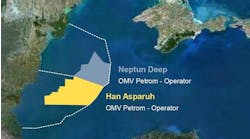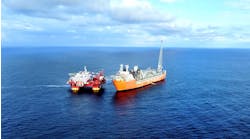Online exclusive: Offshore energy integration could deliver 30% of the UK’s 2050 net-zero target
Myles Mantle and Shu Shu Wong, Haynes and Boone
In early August, the Oil and Gas Authority (OGA) published its final report on the Energy Integration Project in collaboration with Ofgem, the Crown Estate and the Department for Business, Energy and Industrial Strategy (BEIS). The report highlights that the integration of offshore energy systems, including oil and gas, renewables, hydrogen (both blue and green) and carbon capture and storage (CCS), has the potential to contribute to approximately 30% of the UK’s total carbon reduction requirements that is needed to meet the 2050 net zero target.
Significantly, the report also reveals that additional offshore renewable power generation in the form of wind, wave and tidal energy could contribute a further 30% towards the UK’s net zero target. What this means is that activities in the UK Continental Shelf (UKCS) could support in total around 60% of the UK’s decarbonization requirements.
The key findings of the report include:
* Current energy integration projects – there are currently already over 30 energy integration projects in progress across the UKCS, such as HyNet (blue hydrogen and CCS repurposing oil and gas infrastructure) and DolpHyn (integrating floating wind power and green hydrogen).
* Platform electrification – oil and gas platform electrification will play a crucial role in cutting sector production emissions in the short-term and is critical to the industry’s social license to operate. Electrification can reduce operational emissions by 2-3MtCO2 p.a. by 2030 which is equivalent to reducing 20% of today’s production emissions, increasing to 40% by 2030.
* Expansion of offshore renewables – oil and gas capabilities, infrastructure and supply chain are crucial to energy integration, and can potentially support further offshore renewables expansion, including floating wind power.
* Acceleration of CCS – re-using oil and gas reservoirs and infrastructure can accelerate CCS, connecting to onshore net zero hubs and saving 20-30% Capex on certain projects. It is worth noting that to reach the CCS scale in support of net zero, the UK needs to develop around 20 individual CO2 stores for a total capacity of over 3GtCO2 by 2050 (with large CCS projects featuring multiple stores).
* Potential of blue hydrogen – blue hydrogen, which is produced by steam reforming natural gas into hydrogen with carbon dioxide as a by-product, has the potential to decarbonize around 30% of the UK natural gas supply by 2050. The development of blue hydrogen therefore has the potential of accelerating CCS ramp-up by supporting more scalable business cases. In addition, a faster growth timeline could support more opportunities to reuse oil and gas assets, such as terminals, pipelines and natural gas resources.
* Potential of green hydrogen – green hydrogen, which is produced by the electrolysis of water into hydrogen with oxygen as a by-product, can support and enable the significant expansion of offshore renewables in the 2030s and beyond, primarily by addressing energy intermittency through the ‘power to gas’ idea (production of hydrogen through electrolysis powered by renewables when capacity allows it), thereby providing an efficient storage solution, as well as ultimately an energy transportation solution (potentially through use of chemical media, such as methanol or ammonia). The report identifies that costs of electrolysis technology needs to come down in order to facilitate wider uptake.
Achieving net zero
The report sets out a clear path towards achieving net zero in the UK and demonstrates that activities in the UKCS, including offshore energy integration and the development of offshore renewable power generation, have the potential to deliver significant and long-lasting carbon reductions.
In particular, the sharing of existing skills, expertise and infrastructure from the oil and gas industry and its supply chain will be vital in the development of the renewables energy sector and in unlocking opportunities for the integration of the offshore energy system. The oil and gas sector therefore has an important role to play in supporting the UK’s transition to a future with net zero greenhouse emissions.
Next steps and looking ahead
The expansion of offshore wind, the growth of hydrogen as an alternative fuel and the development of CCS infrastructure no doubt offer opportunities to diversify and expand the UK’s supply chain, and to create new jobs and new export opportunities – and ultimately making a crucial contribution to the UK’s 2050 net zero targets.
However, the report identifies a number of key actions and areas that must be addressed in the coming months and years in order to maximize the potential of activities in the UKCS:
* Support energy integration pioneering projects – there are currently around 60 projects (including international projects) in the pipeline of energy integration activities in the North Sea and it will be important to (a) help identify key economic hurdles and define approaches to improve project viability, (b) raise cross-industry awareness and promote awareness to realize synergies, (c) have timely communication with key regulators regarding potential barriers and enablers, and (d) ensure that learnings from individual projects are widely leveraged across industry and government.
* Enhance regulatory processes and coordination – there are at present regulatory regimes in place covering the different sectors operating in the UKCS and energy integration projects would require close cross-regulatory co-ordination to understand and manage requirements and timeline dependencies optimally. For instance, further clarity is required on aspects such as seabed leasing over oil and gas acreage and consenting of shared cables and transformers; and for hydrogen projects, there is currently no guidance on requirements over local planning. The report recommends aligning planning and consenting regimes to support cross-industry opportunities (e.g. oil and gas, carbon capture storage and blue and then ultimately green hydrogen).
* Promote greater data availability and ease of access – data consolidation in putting together the report helped to identify cross-industry opportunities and optimal build-up scenarios. Going forward, better information access, data quality and the enhancement of data sets will be critical to support government and industry decision-making. Greater industry data sharing would also support planning and operational efficiencies.
The close coordination and integration of the technologies in oil and gas, renewables, hydrogen and CCS is valuable not only in terms of energy production and cutting greenhouse gases, but also in terms of improving the economics of these technologies. Provided that the challenges and hurdles identified in the report are addressed, the impact of offshore energy integration and offshore renewable power generation in the UKCS on the UK’s targets to achieve net zero by 2050 is significant and far-reaching.



